Small SUV comparison test: Volkswagen T-Roc v Mazda CX-30 v Kia Seltos
Small SUVs are some of the most popular new cars in the country, we compare three of the best to find out which is worth your hard earned.
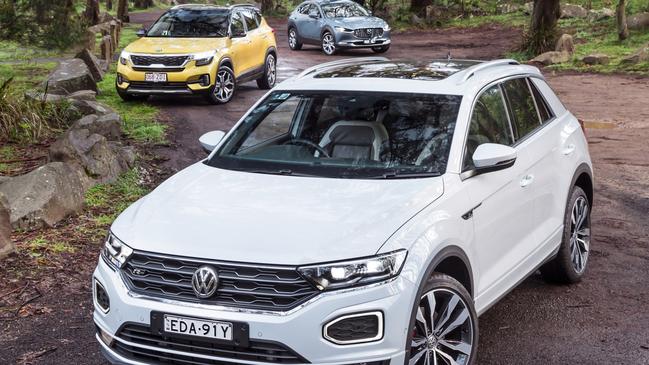
car advice
Don't miss out on the headlines from car advice. Followed categories will be added to My News.
The booming growth of small SUVs is such that all three were unavailable a year ago. Volkswagen’s T-Roc, Mazda’s CX-30 and Kia’s Seltos are new names for Australian motorists.
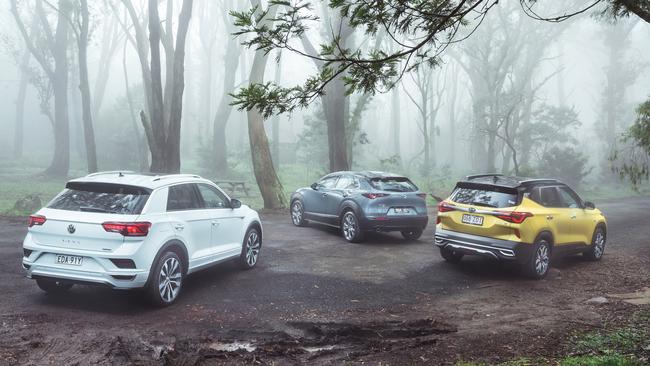
All are ready for buyers stepping up – quite literally – from conventional hatchbacks and sedans. They’re bigger than baby SUVs but smaller than family-oriented models.
VOLKSWAGEN T-ROC
Volkswagen is late to the baby SUV party, and the new T-Roc comes later still, reaching dealers nearly three years after its European debut.
Based on the popular Golf, VW says its car “really rocks the segment” by bringing Golf GTI know-how to a relatively new class of car.
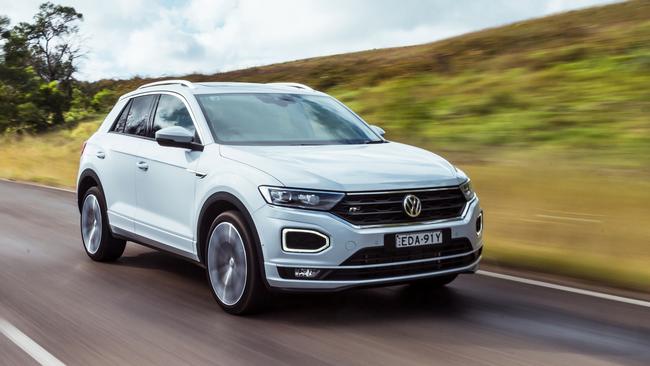
While Mazda customers choose from eight CX-30 models and Kia serves up five Seltos, there is really just one T-Roc in Volkswagen showrooms — two if you count a mechanically identical red-and-white tribute to VW’s Sydney Swans sponsorship.
Priced from $40,490 plus on-road costs, or about $46,000 drive-away, the T-Roc isn’t cheap. But you get cool tech such as a digital dashboard and 8-inch infotainment screen with sat nav, smartphone mirroring and wireless charging.
Safety gear includes auto emergency braking, rear cross traffic alert and lane keeping assistance.
Handsome 19-inch wheels shown here are part of a $2000 pack including multi-mode suspension and a Beats stereo. Leather, a panoramic sunroof and powered tailgate are bundled together for $3500. VW servicing is also dear, near-doubling the non-turbo Mazda and clearing the Kia by more than $1000.
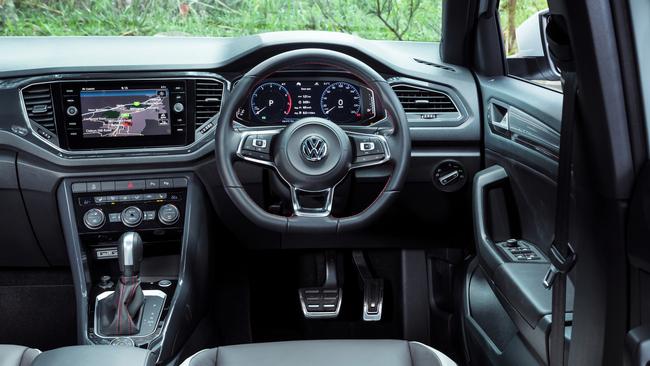
Power comes from a turbocharged 2.0-litre engine which uses 7.2L/100km to send strong 140kW/320Nm figures to all four wheels through a seven-speed dual-clutch automatic transmission.
Crisp looks meet a sporty interior anchored by a flat-bottomed steering wheel. The best driving position of this trio places you low in the car, and the digital dash makes rivals look old-hat. Fans of the band will notice cabin plastics that are a step down from VW’s usual fare.
Rear seat occupants get a good degree of space, plus power outlets and air vents.
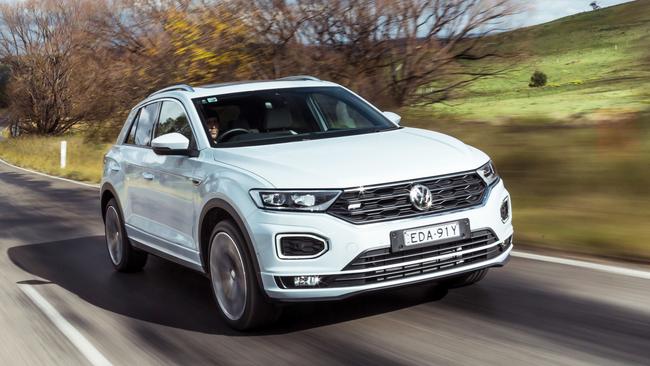
But the happiest person will be the driver, as the T-Roc is a delight to steer. Quicker than rivals here, it keys into the road with impressive tenacity and composure in the bends. Responses to steering and brake input are beautifully measured.
The trade-off is a ride on the firm side of plush, part of its pseudo-GTI nature.
MAZDA CX-30
Slotting in between the Mazda CX-3 and CX-5, the new CX-30 blends an eye-catching cabin with more rear space and a lofty stance.
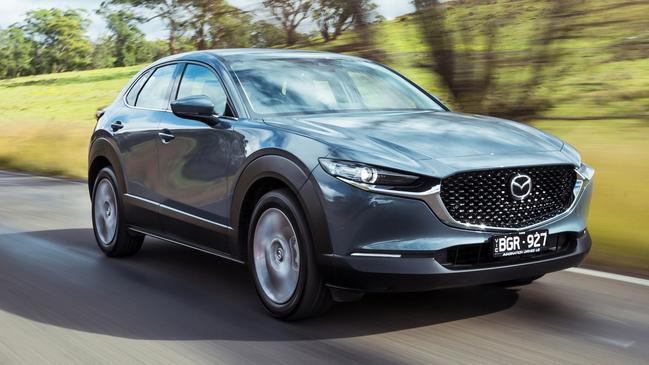
The interior features better materials than the Volkswagen, though rear space is tighter and there’s no power to the back seats. It also has the smallest boot of the lot. Up front, Mazda’s 8.8-inch widescreen display forces you to use a divisive physical controller as opposed to touch inputs to access sat nav and smartphone mirroring.
Few would argue its head-up display is nice to have, as is a safety suite which builds on everything you’ll find in a VW or Kia while adding reverse emergency braking.

The broad CX-30 range spans from about $34,000 to $48,000 drive-away, represented here by the CX-30 G25 Touring model with all-wheel-drive priced from $38,490 plus on-roads, or about $43,000 drive-away.
We picked one with a bigger engine and all-wheel-drive to rival the Volkswagen. Powered by a 2.5-litre non-turbo motor, the Mazda uses 6.8L/100km to make 139kW and 252Nm maximums. It’s the most efficient car here and the cheapest to service.
Leather trim, a head-up display and digital auto come as standard in the CX-30, which benefits from a 360-degree camera and front parking sensors if you spend $1300 more.
Longer than the Kia or Volkswagen, the Mazda also has a ground clearance advantage which could come in handy if you take it beyond tarmac. Tall springs translate to a stiff ride which feels unsettled in this company, conspiring with a noisy suspension action to undermine Mazda’s sound reduction efforts.

The CX-30 steers sweetly but a wooden-feeling brake pedal lets the side down. We also have mixed thoughts about its non-turbo engine, which delivers lag-free responses and decent grunt while making much more noise than the VW.
KIA SELTOS
Like the Mazda, Kia’s new Seltos comes in a variety of flavours spanning $26,690 to $42,690 drive-away. We went with the range-topping Seltos GT-Line model with the most powerful engine and all-wheel-drive traction. Even so, it is the cheapest car here – one packed with kit.
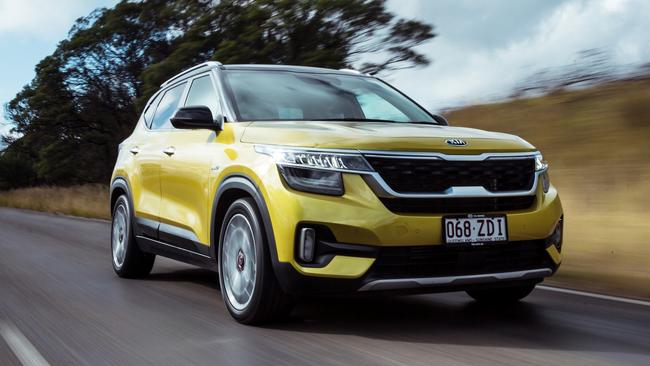
You get a premium Bose stereo, sunroof, three-zone climate control, LED headlights and a power driver’s seat as standard. Other niceties include heated and ventilated front seats, a head-up display, wireless phone charging, sat nav, digital radio and a 10.25-inch infotainment screen with mood lighting that pulses in time to your music.
Seltos customers also get a seven-year, unlimited-kilometre warranty while Mazda and VW bring five-year guarantees.
The cabin isn’t particularly stylish, and faux leather seats aren’t the height of luxury. But it has plenty of equipment and the most headroom in the front or rear, thanks to its taller body. USB points in the rear also make it a winner with families. It also has the biggest boot, the only one with a full-size spare wheel.
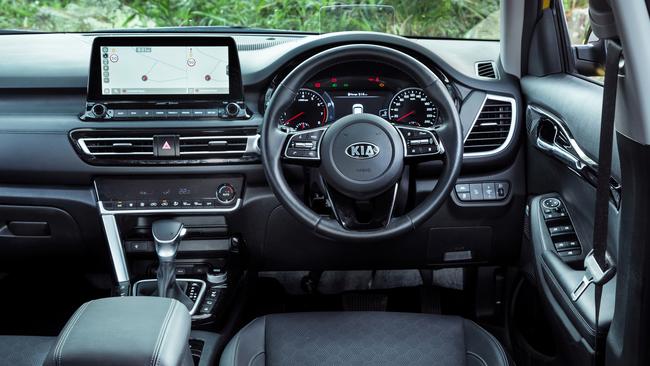
Kia’s compact 1.6-litre engine uses a turbo to deliver 130kW and 265Nm to both axles. Its seven-speed dual-clutch auto isn’t as crisp at speed or smooth around town as the Volkswagen, which has more experience with this transmission type. Official 7.6L/100km fuel use makes it the thirstiest here, possibly because it combines the heaviest body with the least powerful engine. That engine works well around town but can sound boomy when overtaking.
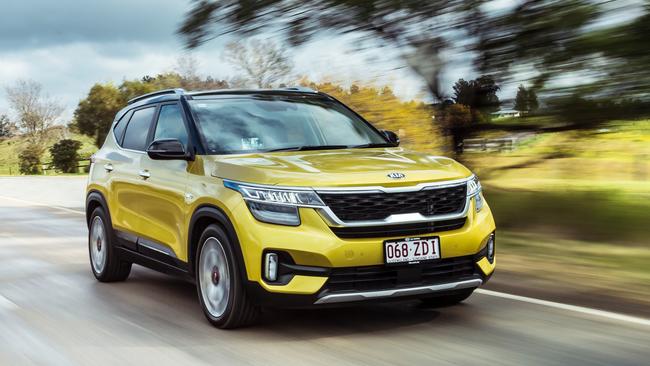
Likewise, the suspension is plusher than either the Volkswagen or Mazda. That’s great on the school run but less impressive on country roads that can induce body roll when cornering, or a heaving sensation after particularly big bumps.
VERDICT
The Mazda takes bronze here, let down by its cosy rear seat and firm ride. The other two are tougher to split. Keen drivers shouldn’t look past the Volkswagen — it’s a great steer, and tech leader for the class. But the Kia’s superior value and usability make it the practical pick.
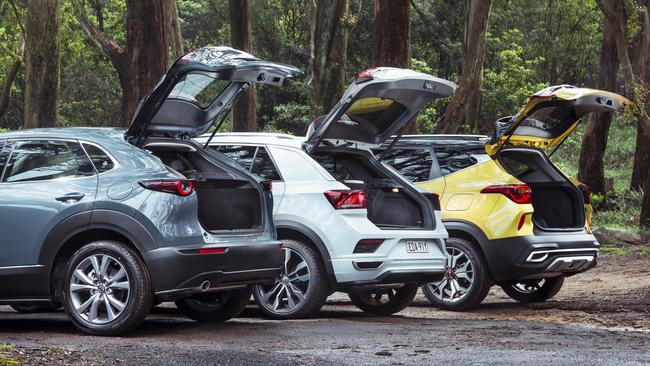
VOLKSWAGEN T-ROC VITALS
Price: From about $46,000 drive-away
Engine: 2.0-litre 4-cyl turbo, 140kW/320Nm
Warranty/Service: 5 year, unlimited km / about $3150 for 5 years
Safety: 5 stars, 6 airbags, AEB, active cruise, lane keep assist, blind spot monitoring, rear cross traffic alert
Thirst: 7.2L/100km
Cargo: 392L
Spare: Space saver
MAZDA CX-30 TOURING VITALS
Price: From about $43,000 drive-away
Engine: 2.5-litre, 4-cylinder, 139kW/252Nm
Warranty/Service: 5 year, unlimited km / $1692 for 5 years
Safety: 5 stars, 6 airbags, front and rear AEB, active cruise, lane keep assist, blind spot monitoring, rear cross traffic alert
Thirst: 6.8L/100km
Cargo: 317L
Spare: Space saver
KIA SELTOS GT-LINE VITALS
Price: From $42,690 drive-away
Engine: 1.6-litre 4-cyl turbo, 130kW/265Nm
Warranty/servicing: 7 year, unlimited km, $1914 for 5 years
Safety: 5 stars, 6 airbags, AEB, active cruise, lane keeping assistance, blind spot monitoring and rear cross traffic alert
Thirst: 7.6L/100km
Cargo: 433L
Spare: Full size
Originally published as Small SUV comparison test: Volkswagen T-Roc v Mazda CX-30 v Kia Seltos
